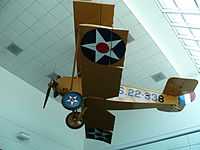The Sperry Messenger was an American single-seat biplane designed by Alfred V. Verville working for the Engineering Division of the United States Army Air Service and built under contract by Sperry Aircraft Company of Farmingdale, New York. The aircraft was later designated the M-1 and MAT by the USAAS. Sperry produced approximately 50 Messengers and the civilian two-seat version, the Sport Plane, between 1920 and 1926.[1]
Development

Sperry landing in front of the steps of the U.S. Capitol.
In 1921 the Engineering Division of the USAAS designed a simple single-seat biplane to be used as a messenger aircraft to replace motorcycles. The aircraft was built by the Sperry Aircraft Company as the Sperry Messenger. The Messenger was a conventional biplane with a fixed tailskid landing gear and a nose mounted 60 hp (45 kW) Lawrance L-4 radial engine. In 1924 the military aircraft were given USAAS designations M-1, M-1A and MAT. Lawrence Sperry gained attention when he landed his personal Messenger in front of the Capitol building and bounced up the front steps in Washington D.C. (See photo to the right.)[2] He also successfully landed his little Messenger at the Lincoln Memorial. The prototype was used by Lawrence Sperry who disappeared in 1923 flying a Messenger across the English Channel from France to England.
Operational history
The Messenger's small size, simple construction, and inexpensive cost made it ideal for testing and experimentation. As well as the original communications duties, the National Advisory Committee for Aeronautics used one in its pioneering aerodynamic research programs from 1923 to 1929. Sperry modified twelve into the radio-controlled Messenger Aerial Torpedo, an early flying bomb, and developed the apparatus for a Messenger to make the first successful airship hook on and release in December 1924.[1]
Variants

A Sperry M-1 at NACA Langley, in 1926.
- Messenger
- Sperry designation, 42 built later given USAAS designations M-1, M-1A and MAT.
- M-1
- Messengers used in communications duties, 26 built and known by the USAAS as the Verville-Sperry M-1[3]
- M-1A
- Messengers with increased fuel capacity, 16 built.
- MAT
- Messengers used as aerial torpedoes (Messenger Aerial Torpedo), eight conversions.
Operators
 United States
United States
Specifications (M-1)
General characteristics
- Crew: 1
- Length: 17 ft 9 in ( m)
- Wingspan: 20 ft 0 in ( m)
- Height: 6 ft 9 in ( m)
- Wing area: 160 ft2 ( m2)
- Empty weight: 623 lb ( kg)
- Gross weight: 862 lb ( kg)
- Powerplant: × Lawrance L-4, 60 hp (45 kW)
Performance
- Maximum speed: 97 mph ( km/h)
- Rate of climb: 700 ft/min ( m/s)
Armament
Gallery
| M-1 Messenger |
|---|
| Replica of M-1 in the Cradle of Aviation Museum |
|
See also
- Related lists
References
- Notes
- Bibliography
- Taylor, Michael J. H. (1989). Jane's Encyclopedia of Aviation. London: Studio Editions.
- The Illustrated Encyclopedia of Aircraft (Part Work 1982-1985). Orbis Publishing. p. 2955.
External links
USAAS Messenger 1919-1924 |
|---|
|
M-1
No other designations were assigned in this sequence |
|
|
|---|
| | General | |
|---|
| | Military | |
|---|
| | Accidents/incidents | |
|---|
| | Records | |
|---|
|






